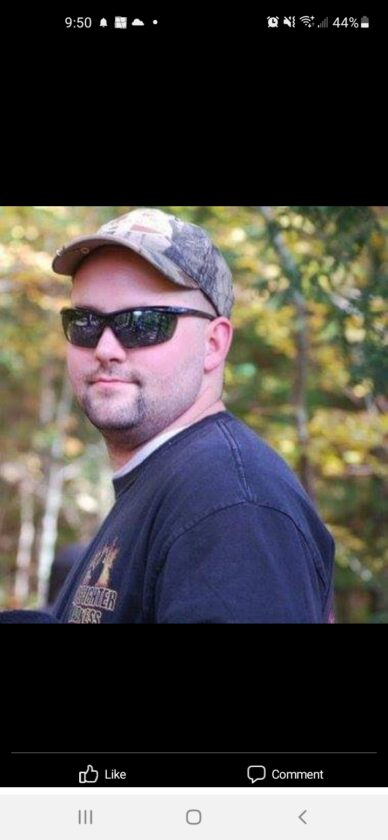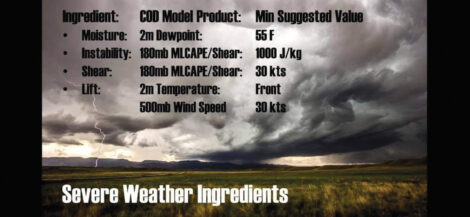Eyes on the sky
Spotters keep community posted on inclement weather
- Photo courtesy of Chris Lee A photo of storm clouds taken by Chris Lee just north off New Ulm while storm spotting this year.
- Chris Lee
- Mike Plocher
- Justin Hicks
- Photo courtesy of Justin Hicks A look at a storm structure on May 30 taken by Hicks in Hanska.
- Submitted information courtesy of Chris Lee The ingredients for tornadoes and severe weather.
- Submitted information courtesy of Chris Lee The ingredients for tornadoes and severe weather.

Photo courtesy of Chris Lee A photo of storm clouds taken by Chris Lee just north off New Ulm while storm spotting this year.
NEW ULM — There are many ways to be informed and stay safe from incoming inclement weather.
And it goes beyond the touch of a radio dial or a TV remote.
Trained storm spotters play a huge role in helping keep their communities safe with reports to the National Weather Service (NWS).
For those in the Brown County area, Brown County MN Storm Spotters is a Facebook group dedicated to alerting the area of incoming storms by trained spotters.
The group’s founder Chris Lee started the group after noticing there wasn’t one already for Brown County after moving to the area from Steele County, where there is a heavy SKYWARN presence.

Chris Lee
SKYWARN, established by the NWS to obtain criticial weather information, is a volunteer program with more than 350,000 trained severe weather spotters.
Steele County also has officers and fire department that are SKYWARN trained including the neighboring communities.
Lee also noticed previously while working for the New Ulm Police Department that storm spotting was heavily reliant on law enforcement to confirm a sighting instead of having a trained spotter base to rely on like other areas of the state.
“I reached out to Todd Krause with the National Weather Service of Minnesota as well as Keith Haskell of the Steele County SKYWARN group and both informed me that there weren’t many registered and trained SKYWARN spotters in the Brown County area despite the fact that the area is considered the Tornado Alley of Minnesota,” Lee said.
With that in mind, Lee took the opportunity to create a Facebook group, mostly for weather enthusiasts, and build from there.

Mike Plocher
“I asked Keith for his assistance in moderating the group and shortly after, I met Justin Hicks, who then became a group moderator and eventually an Admin of the page. I only really knew Mike Plocher from the page, but I could tell he was an avid weather enthusiast like me based off some of his photos and time-lapse videos.”
Lee reached out to Plocher, a St. Paul’s Lutheran School teacher, to see if he had interest in being a moderator of the group and then eventually a group administrator, which Plocher agreed to.
The page took off after that, especially this spring as Lee, Plocher and Hicks kept the Brown County community posted on incoming storms and their predicted paths. The group now has more than 1,500 followers and it continues to grow, especially when storms are brewing.
Plocher was born in Kansas City, Missouri, and lived in Kansas City, Kansas, as a young child. He spent most of his early years growing up in Michigan. He then moved to New Ulm to get his teaching degree at Martin Luther College before moving to Wisconsin, Oklahoma and back to New Ulm in 2003 to teach at St. Paul’s.
Living in Tornado Alley played a big part in Plocher’s initial interest in storms and weather.

Justin Hicks
“I’ve always loved weather, always knew about it,” Plocher said. “When I was in Madison, Wisconsin, I took an undergraduate course from the University of Wisconsin in meterology, so I took some [interest] with that and thought, ‘That’s kind of cool.’ And in Oklahoma, it’s very different than here in Minnesota — you can see farther. And when a cloud forms, there’s blue sky all around it, you have this massive super cell and you have this trapezoid hanging underneath it. That’s the inflow, you know exactly what it is. And then just reading about it, looking at it, talking to others. Over the years, you know what it is, you know the rotation.
“My dad always liked weather. He took a picture of a funnel cloud when we lived in Kansas. I remember him showing it to me when I was older. He was also outside when bad weather was coming watching the sky. I’d be outside with him and he would explain the clouds to me.”
Hicks, who grew up in Mapleton, had a path to becoming a storm enthusiast and trained spotter that differed quite a bit from Plocher’s.
“I was 16 was when I took my first SKYWARN class,” Hicks said. “I was actually petrified of storms. We were camping up in Whitewater State Park with my cousin who’s a retired firefighter now, and the Park Rangers came back and said, ‘Go to shelter.’ Of course I was freaking out at the time, and he was, like, ‘Get in the truck.’ He was pointing out all of the different [cloud] structures and I was kind of hooked after that. He got me into my first SKYWARN class, so basically since the time I could drive I’ve been [interested in stormspotting].”
Plocher first became a trained spotter with his son.

Photo courtesy of Justin Hicks A look at a storm structure on May 30 taken by Hicks in Hanska.
“To get to New Ulm and realize, ‘Where are the helicopters?'” Plocher said. “So I’d go out and I’d film and I’d call stuff in and I’d watch because I’m, like, ‘There’s nobody out here.’ So to take the class and to join, eventually I thought I’d do that. So I talked to my son, Tim, and a couple years ago, he and I did [the class].”
While anyone can pull up a free weather app on their cell phones, Hicks said he pays for other premium services to keep an eye on potential developing storms. He also has his own radio setup at home to track the weather.
“My radio area, I’ve got two 32-inch monitors that I monitor Sioux Falls radar, Minneapolis radar,” Hicks said. “I can look at four different aspects of the storm.”
All three spotters have experienced their own share of bad storms over the years.
The worst storm Plocher recalls happened on May, 3, 1999, when an F5 tornado ravaged southern and souteastern Oklahoma City. Between May 2-8, 1999, in Oklahoma, 152 total tornadoes touched down, resulting in 50 casualties and almost 900 injuries.

Submitted information courtesy of Chris Lee The ingredients for tornadoes and severe weather.
Plocher lived in the northern part of the city at the time and avoided the destruction, but it still isn’t something he will forget any time soon.
“When that May 3, 1999, tornado went through — that was our big one down there — it was well over a mile-wide at one point,” Plocher said. “When you think about it, the college [MLC] down to the river [in size]. And we watched it live on TV as it’s going through neighborhoods, as it’s going through stuff, and you’d see horizontal vortices spiraling into that thing, talk about incredible. And multiple tornadoes were in that thing.
“You can imagine 5,000 houses when their natural gas is ripped off. It was hard to breathe. All that air was blowing north with that natural gas smell. And I think they ended up with probably three football fields, three-storey high, because you don’t think about appliances. Can you imagine a three-storey high, three football fields of refrigerators, washers, dryers, freezers, you don’t think about that, but they had to put it somewhere.”
Hicks had a couple of bad storms in mind that stand out to him most.
“Back in 2010 down in Brown County, the one [tornado] that went through Bricelyn,” Hicks said. “At the time I had a picture of the tornado and I didn’t realize until I went back home and looked at all my pictures and actually could see it. … I’ve had a couple of those where you just take pictures of cool looking clouds and you get back and it’s, like, ‘I did not notice that little hook hanging down before.’ [laughs].
“I guess the scariest one [for me] was that only decent one that came through last summer. We were in Southwest Minnesota. And it started popping, so we basically hit Pipestone and followed it all the way back. We got wrapped up in the rain, tornado warnings everywhere, and bad area for data, so I didn’t have my radar. I’m not familiar with the area, but the wife is, so she pretty much knew exactly where we were. We came through the town of Chandler right after a storm went through and there were big metal dumpsters blowing across the highway and trees down, tree that got struck by lightning.”
Lee recalls a time when a bad storm got a bit too close for comfort.
“I was working as an officer in Waterville,” Lee said. “We had a storm come through and there had been funnel clouds spotted in the area. I went to meet with a SKYWARN spotter in a nearby cemetery that was up on a hill that overlooked Sakatah Lake. I got to the cemetery and there was another storm chaser there, he was just leaving but I stopped to talk to him. The guy seemed nervous, but I thought it was because I was in uniform still. However, he was actually nervous because we were standing directly under a funnel that was forming and eventually became a waterspout on the lake, and later we watched all five tornadoes form over the lake and become waterspouts.”
The Brown County MN Storm Spotters Facebook group plans to continue keeping the public educated and hopes other trained spotters in Brown County reach out.
Hicks also said he’d like to see more people become trained spotters for safety reasons alone.
Those interested in becoming a SKYWARN trained spotter must attend a free class, which are offered in the spring and are about 2 to 2 1/2 hours long. There are several different sites that host these classes around the state and country. Visit www.weather.gov/SKYWARN for more information.
While Lee has moved to Owatonna, he still keeps a close eye on the group and is confident Plocher and Hicks will continue to raise awareness and get others involved.
“I am confident that between Justin and Mike, they will do what they can to help get an official Brown County SKYWARN group established and possibly even an agreement with [Brown] County to help provide and activate trained spotters when the weather becomes threatening,” Lee said.

Submitted information courtesy of Chris Lee The ingredients for tornadoes and severe weather.












